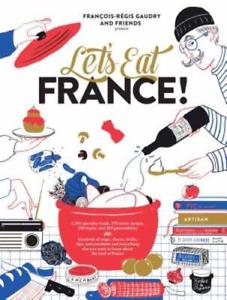
TLS: THE TIMES LITERARY SUPPLEMENT The leading international weekly for literary culture
SOCIAL STUDIES DECEMBER 18, 2018 François-Régis Gaudry and friends
LET’S EAT FRANCE! Translated by Zachary Townsend
432 pp. Artisan. £36 (US $50). From Let’s Eat France!© Photograph by Pierre Javelle Get dressed like an onion Gathering together varied morsels about French food
PAUL LEVY
First published in France last year, Let’s Eat France! looks and feels a touch disappointing. The book’s size and weight make it unwieldy, all the more so since the “poster-size guides” – the highly illustrated double-page spreads of which the work is chiefly composed – make the support of a table necessary. Its red, white and blue wipe-clean cover is almost as garish as its title (originally On va déguster la France or, mysteriously, in the Library of Congress catalogue, “Pourquoi manger la France?”). If you do open it, however, you will probably read every word, enthused by the mass of information in the maps, charts, “inventories” of the ingredients, recipes and gifts of geography and nature that put the cuisine of France on the UNESCO list of Intangible Cultural Heritage in November 2010. Though the author’s credit makes it appear to be (at least mainly) the work of one man, François-Régis Gaudry, a Parisian food critic and broadcaster, nearly every entry carries another writer’s byline, none, save those of the many chefs, familiar to me.
In the week or two it took to digest the contents of this monster tome, I learned a good deal I did not know despite half a century of eating and cooking in France, and could detect few errors (leaving the blood out of a recipe for civet of hare is one). Another omission can probably be put down to chauvinism – in its original sense of exaggerated patriotic pride. The cover illustration, with its witty puns (the moustachioed cook in his matelot jersey is pouring “Château Magot, Grand Vin Classé” into a marmite) shows a pile of books, including one – in French – purporting to be the History of the Quiche, from Pre-history to the Present Day, volume 1. Another, though, Le Guide Culinaire by Auguste Escoffier, appears to be a genuine homage to the “Cook of Kings and King of Cooks” (1846–1935), who codified French cuisine, set the standards of restaurant service, raised the social standing of chefs and improved their working conditions, and who was the business partner of the more famous César Ritz. The full entry on Escoffier by Charles Patin O’Coohoon, however, doesn’t mention that both Ritz and Escoffier were crooks, sacked from their stellar jobs at the recently built Savoy Hotel in London on February 28, 1898, for fraud and embezzlement in the spectacular amount of £19,137, equivalent to £2,412,123 in 2018. Readers of this paper may know that I claim the credit for this scoop (TLS, December 20, 2002), but the salient point is that this has been reported many times all over the world except, it seems, in France. Why not? Perhaps because Escoffier is a secular saint; a French one, too, fired by Englishmen, and for the usual cheffy reasons.
Similarly, among the 260 foodie “personalities” profiled, there is only a handful of non-French examples, including Stanisław Leszczyński (Stanislas I of Poland, 1704–1709, whose pâtissier, Nicolas Stohorer concocted the baba au rhum), Julia Child and Ernest Hemingway. Surely Richard Olney is worthy of inclusion. But the potted biographies are succinct and contain the useful information one would expect of a good reference work, with a splendid index and massive bibliography. There’s even an anthology of modern-day food notables, from the anthropologist Claude Lévi-Strauss and the philosopher Jean- François Revel to the pair of power journalists, François Simon and Gilles Pudlowski – jointly called “The Gastrocrats”. (Although there are scores of world-renowned non-French historians of France and her cuisine. Why omit Theodore Zeldin?) This feature, incidentally but pleasingly, shares a page with two columns about eating frogs, in which is pointed out the discovery at Stonehenge in 2013 of “a significant deposit of frog-leg bones cooked and eaten at least 8,000 years ago”. Who’s froggy now?
It is only on the last page, and in small type, that the translator, Zachary R. Townsend, is credited, for a task that seems heroic. There are at least half a dozen spreads that incorporate slang expressions. Following a note on the etymology of oignon – “Its bulb does not divide (unlike its cousins garlic, shallot and chives) so its etymological origin is from unio (‘uni’) meaning ‘one’” – there is a clutch of these instances of argot. “Aux petits oignons” means “cajoled, pampered”; “En rang d’oignons”, “aligned one behind the other, in order of size”; “Occupe-toi de tes oignons”, “this does not concern you”; “Être vêtu comme un oignon”, “wear several layers of clothing”. On the other hand, as the volume has been translated into American, rather than English (though the usable, original metric measures are helpfully given alongside the American cups and spoons), it does get into the usual trouble, especially over the potato, so that “fries” means “chips” and “chips” means “crisps”. The biblical names of outsize Champagne bottles are left in their improbable French spellings – e.g. the 15-litre, twenty-bottle chap is “Nabuchodonosor”.
However, what cook would not cherish a book that pictures the varieties of vanilla, pasta, chickpeas, cherries, croissants, edible seaweeds, garlic, herbal teas, molluscs, bread, black pudding, sweets (“candies”), Camembert, omelettes, testicles, knives, French whiskey (more than 3 million bottles “are forecasted by 2020”), and great chefs who died before they were aged sixty? Not to mention the book’s display of all the things that can be made from pâte à choux, inventories of the cows, chickens, pigs and sheep of France, plus lists of dishes attributed to abbeys (from à la Bénédictine to Visitandine), the national hams, cheeses for melting, and tips on choosing foie gras. And do not overlook the entries on “The Erotics of Cooking”, where you will discover the meaning of “take it in the baba”, or “Bad Taste”, where you will learn about the suggestive oval confection called coucougnettes. Despite minor flaws, Let’s Eat France! is learned, comprehensive and wholly entertaining.
Copyright © The Times Literary Supplement Limited 2018. The Times Literary Supplement Limited: 1 London Bridge Street, London SE1 9GF. Registered in England.
Company registration number: 935240. VAT no: GB 243 8054 69.
Millwood Farmhouse
Millwood End
Long Hanborough
Witney OX29 8BP
T:+44 (0)1993 881 312
paullevy@paullevy.com
www.paullevy.com
